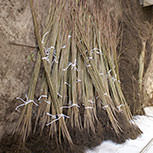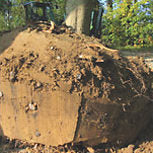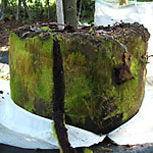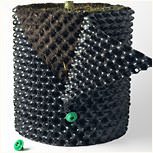
OUR TREES
Why Roots are so Important
Why Roots are so Important

The secret to finding a tree that will flourish when planted is to look down as well as up! Trees can only absorb water from the tips of their youngest, finest roots, so an undisturbed, fibrous, non-spiralling root system is most desirable.
Unfortunately, preserving that undisturbed environment when transplanting trees is a weighty- and therefore more costly- undertaking. As a result, Over the years a range of ‘root protection’ (or `root system` or simply `root`) specification options have evolved to suit a variety of budgets and site conditions. This practic works fine for an experienced tree buyer, but can spell disaster for the unsuspecting novice. It is very easy for an unscrupulous grower to sell trees at knock-down prices by skimping on root cultivation, or simply neglecting to mention to a novice comparison shopper that the tree being quoted will be supplied with an …er…how-shall-we-say… ‘economy’ root specification.
Our advice is to ALWAYS confirm root specifications when comparison shopping and certainly before committing to buying a tree. Here we explain the various options available by increasing quality.

Whip

Unbranched slender seedlings of approximately 1 meter tall, with perhaps a few fine roots. Whips are best used in dense plantings such as informal hedges, woodland replanting, etc. where high volumes are needed and failure rate will not destroy the planting design. It is important to use easy-to-root varieties unless you are very experienced and able to provide a fairly intense level of support through the establishment phase. Whips provide negligible visual impact on planting.
Bareroot

Field grown trees are cut out of the ground and soil shaken off to economise on weight. Cheap and cheerful and fine for easy-to-root varieties and broad scale planting (woodland planting, young hedging), where a high failure rate is acceptable. Bareroot trees can only be planted in winter. Expect a significant failure rate – up to 50% or even higher for some varieties and site conditions. Bareroot stock is seldom guaranteed.
Rootball

Field grown trees are cut out of the ground and wrapped in hessian sacking with the soil left intact. Quality suppliers will have regularly transplanted and undercut the stock before the final lifting for sale – but be aware that skimping on undercutting is an easy way to cut costs. Rootballed trees have had their roots cut at lifting, so they have lost most of their fine fibrous roots and can only be planted in winter, take longer to establish, and have a significant failure rate, varying by species. Using rootball stock can be an economic way of planting easy-rooting species, but requires careful aftercare provision to ensure success.
Conventional Container Grown

Field grown trees are lifted and planted into plastic containers to allow roots to regenerate prior to planting. A more expensive but better value method, compared to bareroot and rootballed, with a good success rate that enables year-round planting. The main disadvantage of the container method is that it does not promote production of fibrous root system, but rather the familiar ‘pot-bound’ effect of thick, spiralling roots, which are not very efficient at water absorption.
Bagged

Similar to the container method, but bags are substituted for plastic pots for ease of handling (and manoeuvrability). Convenient, but as shown in the photograph, roots typically hit the sides of the bag and are deflected downwards. Better than bareroot, rootball or a conventional pot, but greatly inferior in root development to an Air-Pot grown tree.
Air-Pot

The highest quality specification for root protection. Trees are rooted out into ‘Air-Pots’, a specially designed containerising system which fosters rapid development of a dense, fibrous root system with an abundance of white tip roots. Air-Pot grown trees can therefore be transplanted with negligible root disturbance, making them the fastest and easiest specimens to establish and returning a virtual 100% establishment rate.
Useful Links
-
-
Understanding the Form Specification
ViewAn illustrated guide to the cultivated shape options available.
-
-
-

